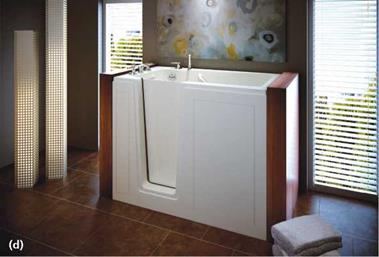The ease of entry and exit and the flexibility to sit or stand that can be designed into the shower probably contribute to the current preference for showering as our main method of personal hygiene. Based on size and design, there are two categories of showers relating to access, the transfer shower and the roll-in shower.
Transfer Shower The transfer shower must have a 36 inch by 36 inch (914 mm by 914 mm) finished interior dimension, with an L-shaped grab bar on the control and half of the back wall, a fold-up seat on the wall opposite the control wall, and a full 36-inch (914 mm) opening. These specifications must be precise to succeed at creating a space where anyone using the shower will have controls and support within reach at all times. It is important to note that, based on a client’s needs, the transfer shower, although smaller, can be the better choice. When the clear floor space adjacent to the shower is sufficient, most standing or seated users will be able to use this shower independently. Access Standards suggest that the clear floor space adjacent to the transfer shower should be a minimum of 48 inches along the opening and extending beyond the opening on the seat wall, by 36 inches in depth(1219 mm by 914 mm) (see Figure 8.27).
However, a more generous clear space of 60 inches (1524 mm) in length will make showering easier for most people using a mobility aid, allowing for the positioning of the wheelchair to line up with the shower seat or to access the controls, and 60 inches (1524 mm)(see Figure 8.28) in depth would provide the turning clearance for that same bather.
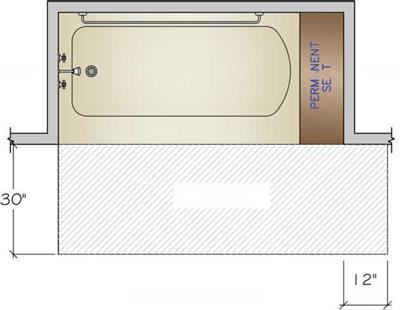 Because the shower interior is so small, the transfer shower is not always designed as a no-threshold shower. When possible, making the area outside the shower a wet area by extending the waterproof membrane and sloping the floor gently toward the drain will make it possible to consider no threshold for this fixture (see Figure 8.29). With or without a raised threshold, care must
Because the shower interior is so small, the transfer shower is not always designed as a no-threshold shower. When possible, making the area outside the shower a wet area by extending the waterproof membrane and sloping the floor gently toward the drain will make it possible to consider no threshold for this fixture (see Figure 8.29). With or without a raised threshold, care must
![]()
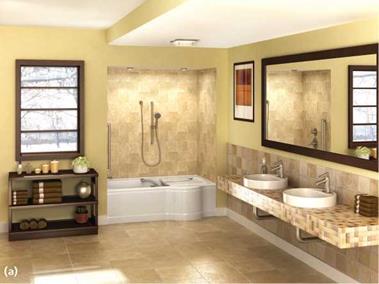
|
|
|

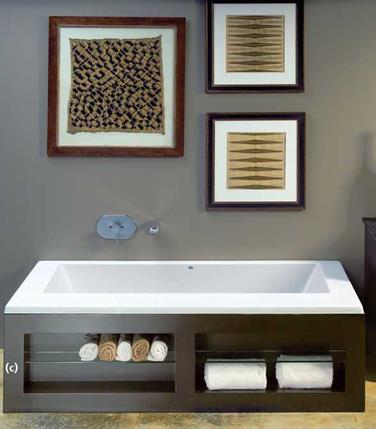
FIGURE 8.26 A sampling of available tub designs with door, seat, and deck.
Courtesy of (A): Delta Faucet; (B) Kohler Company; (C) MTI
|

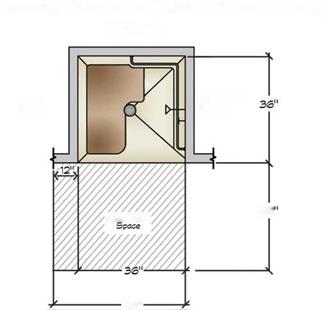
be taken to contain the water in a shower this size. Adding a second drain outside the shower, or using a trench-style drain can help with this, and there are many products available to streamline this process (see Figure 8.30). While a door will contain the water, it can be difficult to plan a door that will provide the 36-inch (914 mm) opening and still not interfere with maneuvering space. A shower curtain that is long enough to drop onto the floor and weighted to hold it down will help, and the curtain can be tied back when not in use, eliminating the obstruction.
Roll-in Shower A roll-in shower is a large waterproof area with no threshold or a flush threshold. This design is easier for children, those of us with balance issues and in general, most people
TRANSFER TYPE SHOWER (ACCESS STANDARD 9-ANSI)
BACK WALL
FOLDING
|
|
|
|
![]()
FIGURE 8.27 Access Standard 9: Minimum clear floor space at transfer shower.
NKBA
|
|
|

to use, and it is particularly accommodating to a person using a wheelchair, as he/she is able to NKBA roll in and remain in the shower chair while showering. Most recommendations for access suggest a minimum 60 inches wide by 30 inches deep (1524 mm by 762 mm), which allows for conversion from a traditional bathtub to a shower in the existing space, but to help with water containment, a minimum depth of 36 inches to 42 inches (914 mm to 1067 mm) is preferred for a roll-in shower. Ideal dimensions are 60 inches wide by 48 to 60 inches deep (1524 mm by 1219 mm by1524 mm), (see Figure 6.50b in chapter 6) which makes entry and full turning easier for the bather using a wheelchair, and improves water containment. Given the current enthusiasm for generous size and Euro-style shower spaces, this is becoming a universal approach, with the
|

benefits expanding to include bathing pets, dual or multiple user showering, and more (refer to chapter 6, "Bathroom Planning").
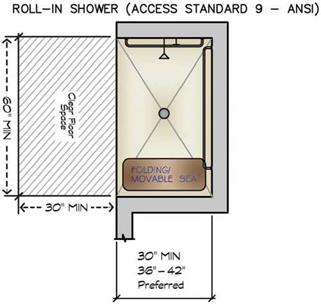

The clear floor space in front of a roll-in shower compartment should be at least 60 inches (1 524 mm) long next to the open face of the shower compartment and a minimum 30 inches wide (762 mm) (see Figure 8.31). As with the transfer shower, a more generous clear space will allow for easier maneuvering. To accommodate turning to enter the shower by a person using a wheelchair, the width of the entry opening must be considered. When using glass or other inflexible materials for the fixed panel and the door, the width of the door opening can be critical to the user who will roll in. If the shower is not more than 42 inches (1067 mm) deep, the door opening will need to be 36 inches (914 mm) to allow the seated bather to maneuver into the space, including
turning at the entry. If the shower is deeper, as shown at 60 inches (1524 mm), the opening can shrink to 32 inches (813 mm) as the bather can roll straight in before turning to the right position for showering (see Figure 8.32). The option of a seat in the shower is always good, and in a roll-in shower, it should be a folding type or designed not to interfere with the clear floor space. One location is on the wall adjacent to the controls. A second option presented in recent code updates is to have the seat on the end wall opposite the controls and when this is the case, care must be given to be sure the seated user will have access to the controls and the handheld spray.
 |
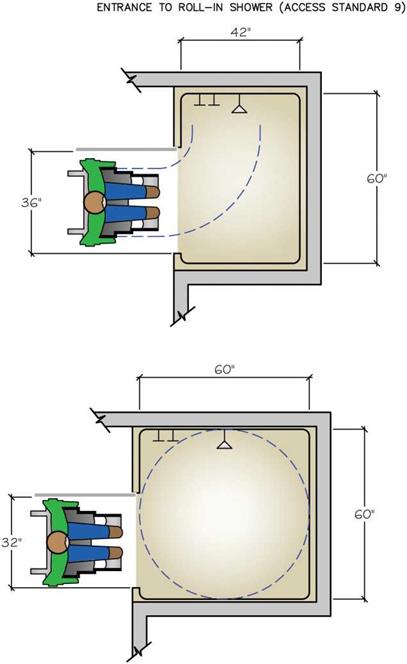 |
Wet Room Planning the entire bathroom as a wet area, with a supplemental or second drain in the room and the waterproof membrane extended well beyond the shower or under the entire floor of the room, makes a very flexible space and easier water containment and maintenance. As mentioned above, this can be a good solution when working with a transfer
shower and water containment. It is especially helpful when struggling to find sufficient clear floor space in a small bathroom, as the lack of thresholds makes the entire space available for maneuvering.

